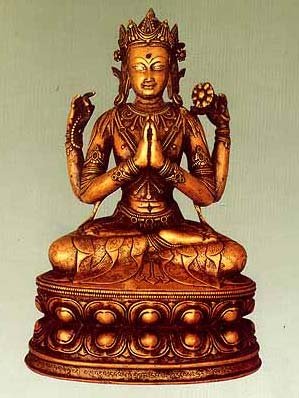Lumbinivana, Lumbini-vana, Lumbinīvana: 2 definitions
Introduction:
Lumbinivana means something in Buddhism, Pali, the history of ancient India. If you want to know the exact meaning, history, etymology or English translation of this term then check out the descriptions on this page. Add your comment or reference to a book if you want to contribute to this summary article.
In Buddhism
Mahayana (major branch of Buddhism)
Source: Wisdom Library: Maha Prajnaparamita SastraLumbinīvana (लुम्बिनीवन) or simply Lumbinī is the name of an ancient forest, according to Mahāprajñāpāramitāśāstra (chapter 41).—Accordingly, “[The eighteen āveṇika-dharmas (‘special attributes’)]— [...] (6). The Buddha has no unconsidered equanimity.—He has no unconsidered equanimity.—[...] [Question].—What are the reasons why he leaves them knowingly? [Answer].—In the middle of the great assemblies, the Buddha is tired and that is why he wants to rest for a while. Furthermore, from lifetime to lifetime, the Buddha has always liked solitude (naiṣkramya). When, as a Bodhisattva, he was in his mother’s womb (mātṛkukṣi), his mother loved solitude as well, and it was at forty li from the capital, in the forest of Lumbinīvana she gave birth to him. [...]”.

Mahayana (महायान, mahāyāna) is a major branch of Buddhism focusing on the path of a Bodhisattva (spiritual aspirants/ enlightened beings). Extant literature is vast and primarely composed in the Sanskrit language. There are many sūtras of which some of the earliest are the various Prajñāpāramitā sūtras.
India history and geography
Source: Ancient Buddhist Texts: Geography of Early BuddhismLumbinivana (लुम्बिनिवन) is the name of a forest situated in Majjhimadesa (Middle Country) of ancient India, as recorded in the Pāli Buddhist texts (detailing the geography of ancient India as it was known in to Early Buddhism).—The Lumbinivana is referred to in the Buddhacarita as situated in Kapilavatthu which is the birth place of the Buddha. Lumbinī is Rumminideī in the Nepalese Terai, 2 miles to the north of Bhagavanpur and about a mile to the north of Paderia.

The history of India traces the identification of countries, villages, towns and other regions of India, as well as mythology, zoology, royal dynasties, rulers, tribes, local festivities and traditions and regional languages. Ancient India enjoyed religious freedom and encourages the path of Dharma, a concept common to Buddhism, Hinduism, and Jainism.
See also (Relevant definitions)
Partial matches: Lumbini, Vana.
Full-text: Abhikirnikrita, Lumbini, Naishkramya, Kumarakrida, Daraka, Aryadharma, Dharmabhajana, Salavana, Uruvilvavana, Devadaha Vagga, Uruvilva, Kapilavatthu.
Relevant text
Search found 1 books and stories containing Lumbinivana, Lumbini-vana, Lumbinīvana, Lumbinī-vana; (plurals include: Lumbinivanas, vanas, Lumbinīvanas). You can also click to the full overview containing English textual excerpts. Below are direct links for the most relevant articles:
Maha Prajnaparamita Sastra (by Gelongma Karma Migme Chödrön)
Part 1 - For what reasons did the Buddha preach Mahāprajñāpāramitāsūtra? < [Chapter I - Explanation of Arguments]
II. Detailed commentary on the list < [Part 1 - Mahāyānist list of the eighteen special attributes of the Buddha]